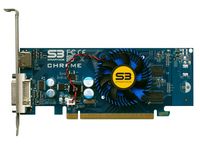S3 Gets a Leg Up on ATI and Nvidia
S3 Graphics is the Rodney Dangerfield of the graphics industry. The company’s Chrome GPUs just don’t get much respect. But the latest model, the Chrome 530 GT, it has a feature none of ATI’s nor Nvidia’s discrete GPUs can match: Support for Microsoft’s Protected Audio Path for passing the Dolby TrueHD and DTS-HD audio on Blu-ray discs over HDMI.
S3’s Chrome 530 GT has an integrated AES engine that’s capable of re-encrypting losslessly compressed audio after it’s pulled off a Blu-ray disc and sent over the PCI Express bus and then out of the PC via HDMI. The chip also features a built-in 7.1-channel Dolby digital surround-sound processor. ATI’s latest GPUs have the integrated audio processor, but they can’t send Dolby TrueHD or DTS-HD over HDMI because they don’t have an AES engine; Nvidia’s newest GPUs have neither an integrated audio processor nor an AES engine.
There’s just one big catch for S3: Its full feature set isn’t supported by any of the software Blu-ray disc players, so the company’s advantage is currently moot. As S3’s Benson Tao told us, “In a nutshell, yes, our hardware already has the support for Dolby TrueHD and DTS-HD over HDMI, but it is up to the ISVs [independent software vendors] to decide how to do the implementation.”
In fact, Tao told us that "the current version of Cyberlink’s PowerDVD 8 Ultra does not recognize the S3 Chrome hardware as a BD player, so you will get an error message when trying our hardware [with that software player]. PowerDVD Cinema 8 which is scheduled to be released by the end of November will support both Chrome 400 and 500 Blu-ray hardware acceleration."
Tao also said that "WinDVD 8, currently bundled with our Chrome 530 GT card, and WinDVD 9 both have native support for our hardware." Unfortunately, that support doesn’t include sending compressed audio over HDMI.
In addition to its Blu-ray support, the Chrome 530 GT S3 also delivers DirectX 10.1 and Shader Model 4.1 compatibility at an extremely low price point of just $44.95. The GPU’s runs at 625MHz and its 512MB of local GDDR2 memory is clocked at 500MHz. The chip can also access system memory using S3’s AcceleRAM technology, but the chip’s memory interface is a relatively narrow 64 bits wide.
The Chrome 530 GT sounds like a weak solution for gamers, but its Blu-ray support and the fact that it won’t require a large and loud cooler could make it the perfect solution for home-theater PCs. Provided, of course, that those ISVs decide to support it before AMD and Nvidia come out with something similar but faster.
Get Tom's Hardware's best news and in-depth reviews, straight to your inbox.
Related Links
-
chaohsiangchen That's really nice. Now I want to see this thing work on a G35 in a HTPC bench-off against G45 and Geforce 9400.Reply -
hannibal For HTPC systems this seems to be good candidate. Really want to see how this will do compared to ATI 4350...Reply
-
timaahhh 512 MB at 500 MHz with a 64 Bit bus? With bandwidth that small is 512 MB even getting used? Would the card even see a performance drop if it decreased its memory to 256 MB or even 128 MB?Reply -
hemelskonijn demonhorde665:Reply
Matrox and S3 did not move to away from the high end market in case of S3 this claim could be mostly right but Matrox still makes high end workstation graphic cards and they make them not only for x86 structured machines.
Just to clarify myself the definition of high end grfx card is based on the application of that card and in there segment at least matrox is doing a great job.
-
zodiacfml i think s3 should focus on the HTPC market now that a lot is buying HD monitors and TV's and they can't come close to AMD and Nvidia.Reply
will love 1080p,usable post processing improvements, low power, fanless heatsink at this price.
